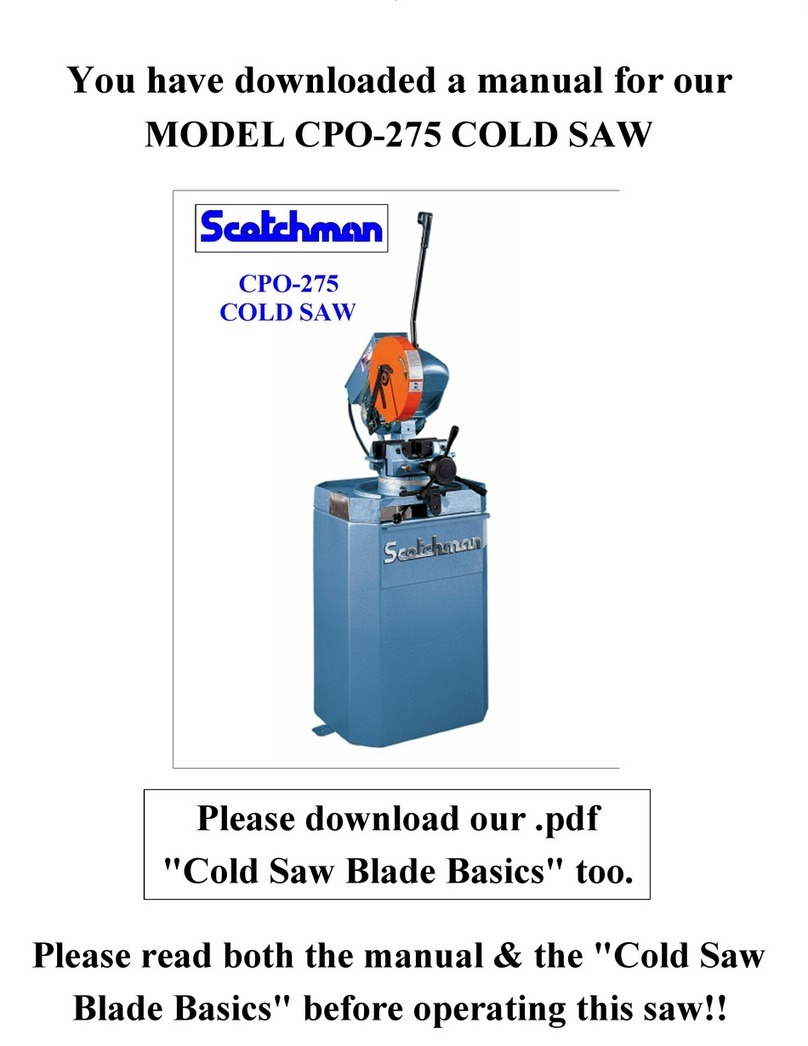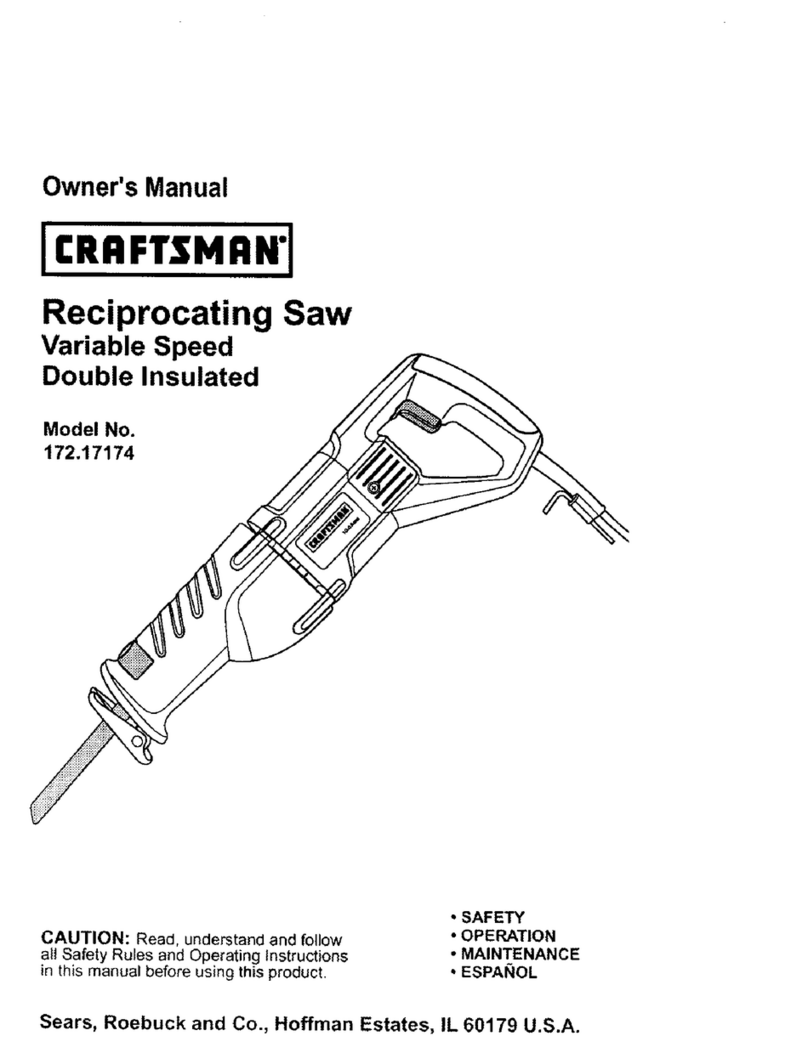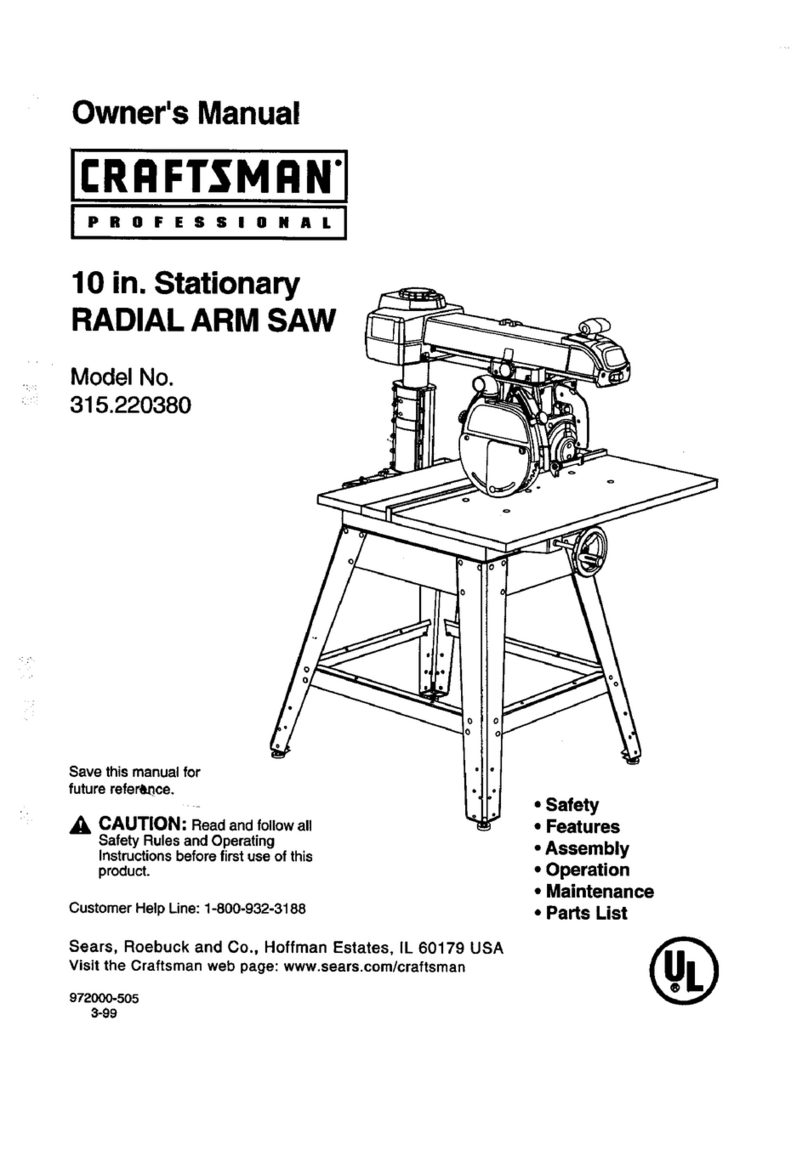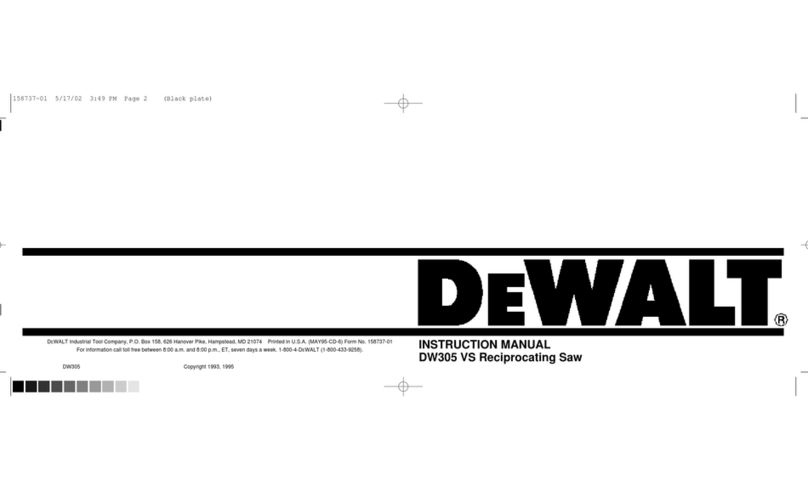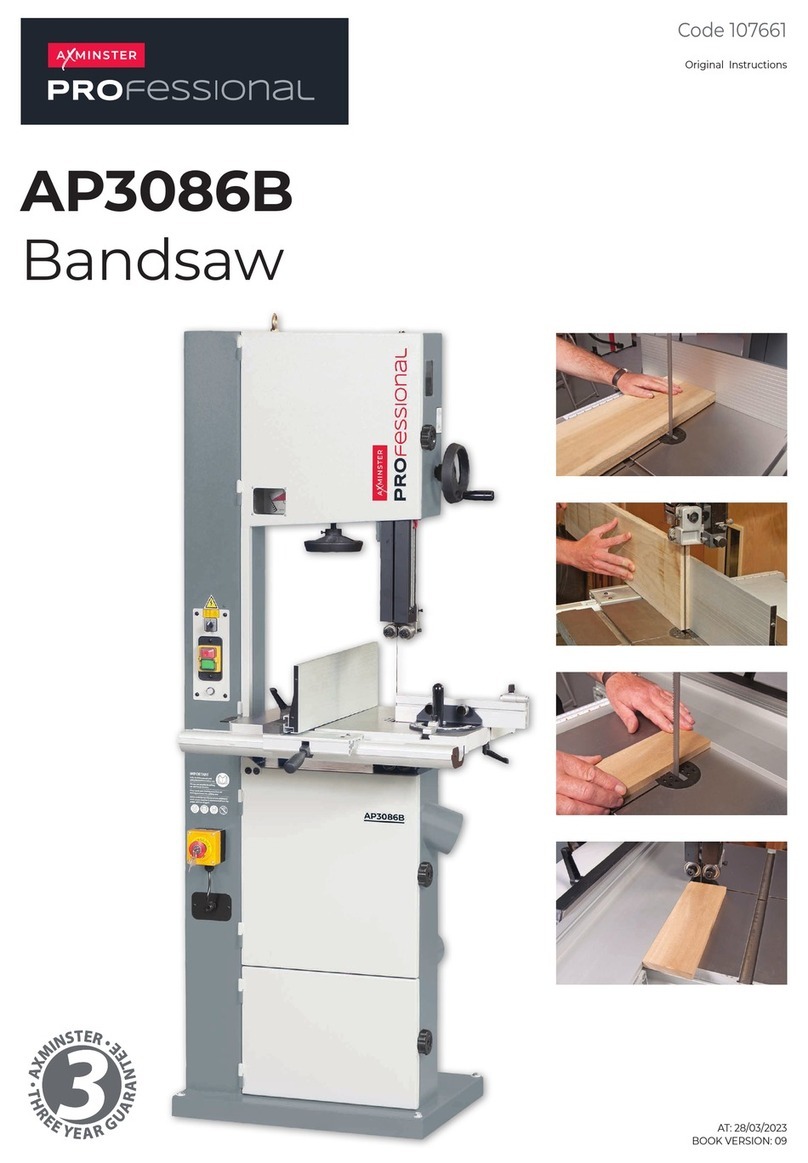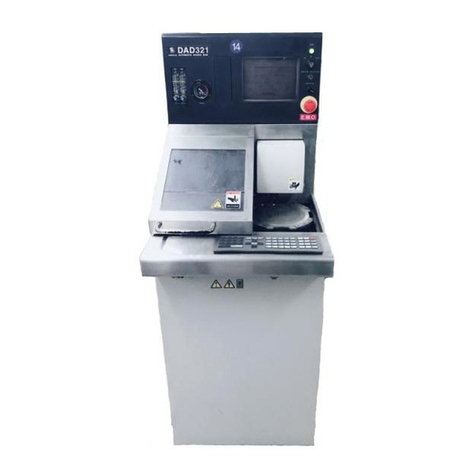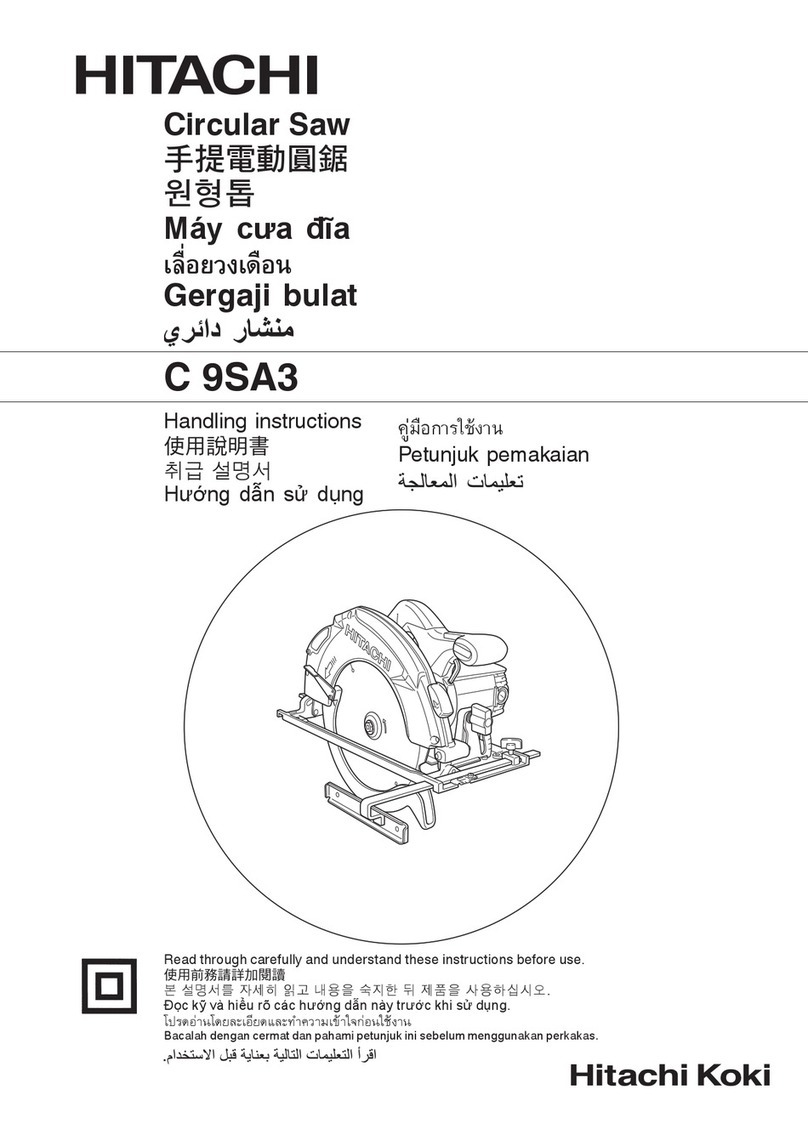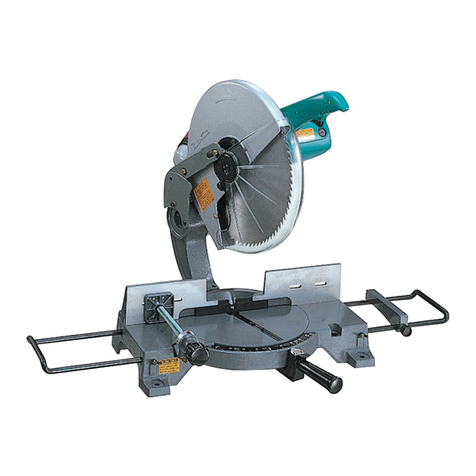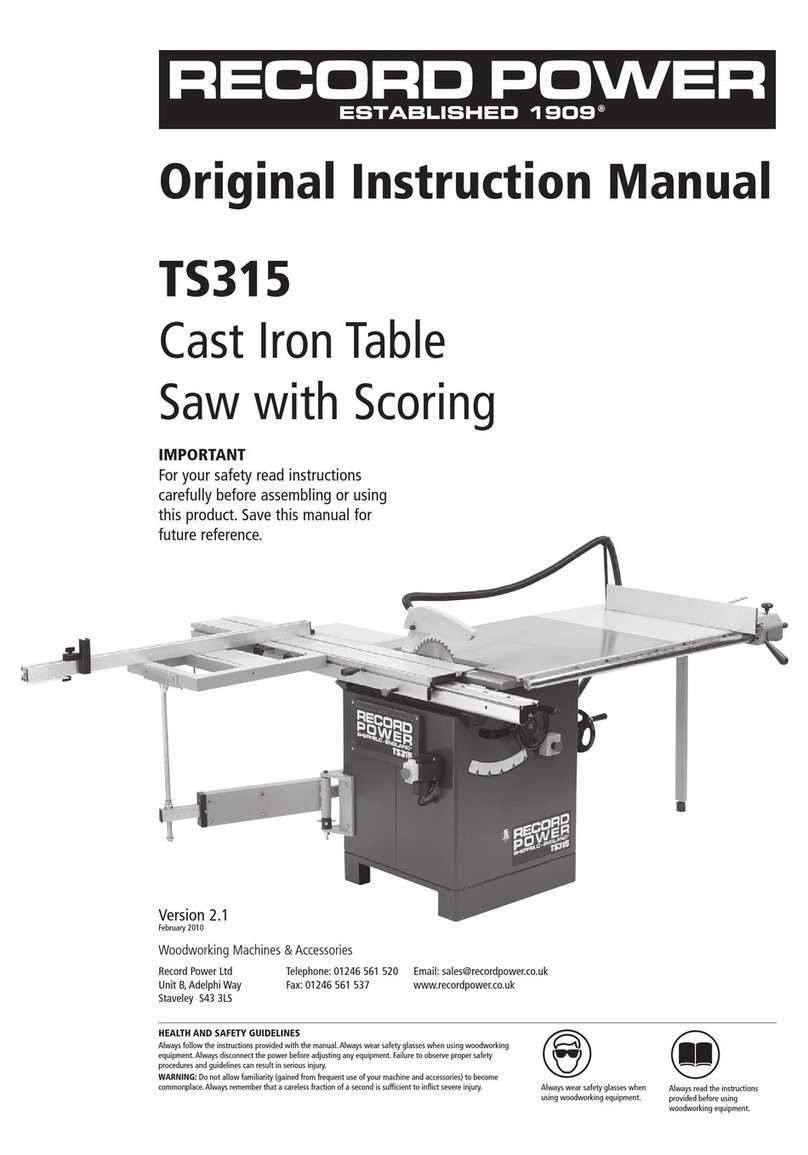Scotchman SU-280 User manual

Page 1
MODEL
SU-280
BAND SAW
PRINTED JULY 2013

Page 2
TABLE OF CONTENTS
1. INTRODUCTION 3
1.1 Legislation applicable to planning and construction 3
2. GENERAL MACHINE INFORMATION 4
2.1 Machine Identification Data 4
3. TECHNICAL DATA 4
3.1 Noise level 4
3.2 Selection of the Band Saw 5
4. INFORMATION ABOUT TRANSPORT AND STORAGE 6
5. INSTRUCTIONS FOR ANCHORING AND SERVICE START-UP 6
5.1 Anchoring Instructions 6
5.2 Connection to the Electric System 7
5.3 Installing the Band Saw Blade 7
5.4 Cutting Coolant 8
6. INSTRUCTIONS FOR USE 8
6.1 Proper and Improper Use 8
6.2 Function of the Operating Mechanisms 8
6.3 Raising and Lowering the Stop 9
7. PROBLEM SOLVING AND CORRECTIVE MAINTENANCE 10
7.1 Adjustment of the Cutting Blade Guides 11
7.2 Changing the Guide Plates 11
8. RECOMMENDATIONS AND MAINTENANCE 12
8.1 Type and frequency of reviews 12
9. GENERAL RULES AND SAFETY CHECKS 12
9.1 Manufacturer recommendations 13
10. RECOMMENDED ACCESSORIES 14
11. DRAWINGS AND SCHEMATICS 16

Page 3
1.0 INTRODUCTION
This instruction manual has been made in compliance with Legislation according to the Machine’s
directive, 2006/42/CEE, and its subsequent amendments. The instruction manual represents an integral
part of the machine. It must be consulted before, during and after the machine is put into service, as well
as whenever it is considered necessary, thereby respecting its content in each and every one of its parts.
This is the only way in which the fundamental objectives that have been established on the basis of this
manual will be reached, such as accident prevention and making optimal use of the machine features.
Within the framework of this manual, all aspects regarding safety and accident prevention on the job
while using the machine have been considered in every detail, herein highlighting the information that is
of greatest interest to the user.
ATTENTION: Carefully read this manual before installing the machine. The manual must be kept
throughout the machine’s lifetime, in a place that is easy to find in the event that it is needed. In the
event that a used machine is sold, the machine shall be sold together with this manual. In the event
that the machine is scrapped, the identification plate and any other document supplied with the
same shall be destroyed.
1.1 Legislation Applicable to Planning and Construction
EN-12100-1 Machine Safety: Basic concepts, general design principles.
EN-12100-2 Machine Safety: Basic concepts, general design principles.
EN-13857 Guarding by distance to prevent contact with hazardous areas of the machine.
EN-60204/1 Electrical equipment of industrial machines.
EN-13850 Machine safety: emergency stop equipment.
2006/42/CEE on “Machine Safety.”
93/68/CEE on the CE Marking (amendment)
73/23/CEE on “Safety of Electrical Material.”
2004/108/CEE on “Electromagnetic Compatibility.”
1.2 WARRANTY
Scotchman Industries, Inc. will, within three years of the date of purchase, replace F.O.B. the factory or refund the purchase
price for any goods which are defective in materials or workmanship, provided the buyer, at the seller’s option, returns the
defective goods freight and delivery prepaid to the seller, which shall be the buyer’s sole and exclusive remedy for defective
goods. This warranty does not apply to machines and/or components which have been altered, changed or modified in any way
or subjected to abuse and abnormal use, inadequate maintenance and lubrication or subjected to use beyond the seller’s
recommended capacities and specifications. In no event shall the seller be liable for labor cost expended on such goods or
consequential damages. The seller shall not be liable to the purchaser or any other person for loss or damage directly or
indirectly arising from the use of the goods or from any other cause.
No officer, employee or agent of the seller is authorized to make any oral representations or warranty of fitness or to waive
any of the foregoing terms of sale and none shall be binding on the seller. Any electrical changes made to the standard machine
due to local electrical code variation must be paid by purchaser.
As we constantly strive to improve our products, we reserve the right to make changes without notification.
This warranty is effective December 1, 2009.

Page 4
2.0 GENERAL MACHINE INFORMATION
2.1 MACHINE IDENTIFICATION DATA
Model: _________________ SU-280
Serial number: ___________
Manufacture year: ________
NOTE: In order to request replacement parts, whether they are covered by the warranty or not,
always state the model and serial number of the machine, as well as the name of the part and the
code that appear in the last chapter of exploded views.
3.0 TECHNICAL DATA
MAIN MOTOR POWER TRIF. 2 VEL.- MONOF. 1.5 HP
MOTOR SPEED3000/1500 RPM - 3,000/1,500 RPM - 1,500 RPM
SHAVINGS PUMP POWER 0,09 Kw/0,12 CV
CUTTING SPEED 80/40 m/min - 262/131 ft/min
ANGLE OF CUT 30° RIGHT
BAND SAW BLADE DIMENSIONS 96.5 X 1"
CUT THICKNESS 1.5mm
CLAMP; MAXIMUM OPENING 290 mm 11.5 INCHES
3.1 NOISE LEVEL
At a distance of 60 cm RUNNING OFF-LOAD 62 dB (A) Leq
MACHINING A 70x50 PROFILE 83 dB (A) Leq

Page 5
3.2 SELECTION OF THE BAND SAW

Page 6
4.0 INFORMATION ABOUT TRANSPORT & STORAGE
Due to the size of the machine, it should be transported on a forklift or by a crane bridge, using slings.
If the machine is left in storage for a long period of time, lubricate periodically. Do not expose to the
elements. The machine is supplied in a properly designed and sized wood crate, and it is also supplied
wrapped in plastic.
CAUTION: Do not improperly dispose of the packaging. Send the materials to be recycled or
eliminated in accordance with current legislation.
5.0 INSTRUCTIONS FOR ANCHORING & SERVICE START-UP
5.1 ANCHORING INSTRUCTIONS
The machine must first be checked in order to ensure that it has not suffered any damage during
transport. If so, immediately contact the manufacturer.
The machine must be installed on a firm surface that is as level as possible in order to reduce vibrations
during operation and so that it operates according to the parameters established by the manufacturer.

Page 7
5.2 CONNECTION TO THE ELECTRIC SYSTEM
Ensure that the power supply voltage corresponds to the voltage on the data plate of the machine.
Connect the cable (4 x 1.5 sleeve) to the electric system, using a plug that is appropriate for the
characteristics of the same, thereby respecting color codes.
After the machine has been connected, verify that the rotation of the hydraulic power pack motor
agrees with the direction indicated by the arrow shown on the same. If the motor rotation is not
correct, reverse the two phase connections of the line and then, check again.
The pneumatic connection must be made to the supply system using a connector that is appropriate for
the connector on the machine. Adjust the pressure at the filtering group.
5.3 INSTALLING THE BAND SAW BLADE
In order to install the band saw blade:
Lift the frame guard and remove the blade guide guards.
Loosen the tension adjuster.
Put on the band saw blade, sending it through the interior of the guides.
Re-tighten the tension adjuster.
Put on all of the guards.
Turn the saw manually and use a brush to lubricate in between the two guides, using SAE 30
lubricating oil.
ATTENTION: When replacing the band saw blade, always use protective gloves.
DANGER: After changing the band saw blade, put on all guards again. It is absolutely prohibited to
work with them removed.

Page 8
5.4 CUTTING COOLANT
When filling the cutting coolant, use pure, synthetic water-soluble coolant and pour it in through the
coolant down-tube on the machine mount.
CAUTION: When it is necessary to empty the liquid coolant tank, do not improperly dispose of the
coolant.
ATTENTION: The use of any other kinds of coolants may cause irreparable damage to the machine,
as well as diminish the quality of the cut and reduce the life of the saw.
6.0 INSTRUCTIONS FOR USE
6.1 PROPER AND IMPROPER USE
Band saw machine for cutting all kinds of ferrous and non-ferrous materials. Use of the machine for
cutting other materials is prohibited. Such use may cause damage to the machine and risk the safety
of the worker.
DANGER: We are hereby not liable for any possible accident caused by the failure to comply with
the aforementioned provision.
6.2 FUNCTION OF THE OPERATING MECHANISMS
1. The vise is closed using lever no. 1. Work with the vise jaws less than ¼ inch (6 mm) from the
material to be secured.
2. Angle locking lever. Set to position C to allow angled rotation.

Page 9
6.3. RAISING AND LOWERING THE STOP
The machine is fitted with lowering stops and a mechanical safety stop. Use the washer on the arc bolt to
adjust the height.
WARNING: When performing the cut, it is important that the saw should be lowered at a constant
rate, with no sharp changes of speed. If the saw becomes jammed in the material, release the
rotation control and raise the head.
IMPORTANT: Always secure the material with the vise jaws and never by hand.

Page 10
7.0 TROUBLESHOOTING/CORRECTIVE MAINTENANCE
PROBLEM POSSIBLE CAUSES
The machine does not start. Check that the main switch is connected to the power supply.
Motor fuse has blown.
2A fuse has blown.
The rear guard has not activated the safety micro-switch, or this is not
working properly.
Check the operating contactor, start-up control and transformer.
Bad quality or out-of-square cut. Tension too low or too high. See Section 5.3
Condition of the cutting saw.
Coolant liquid used. We recommend pure, synthetic coolant
mixed 7 to 1 with water.
Condition of the blade guide plates.
Guide adjustment. See Section 7.1
Excessive wear on blade. Tension too low or too high. See Section 5.3
Guide plates worn.
Excessive pressure from upper plate. See Section 7.1
Downwards feed in high or batch cutting.
Quality or pitch of blade unsuitable for the material or section to be
cut.
Coolant liquid used. We recommend pure, synthetic coolant mixed 7
to 1.
Noises when saw rotates. State of belt guides. See Section 7.2
Excessive tension in cutting saw.
Bearings no. 26, 46 Figure 10.3
State of the cutting blade.
The pressure gauge does not Top up with hydraulic oil (viscosity 32); to do so, the pressure gauge
reach 100 bars. must be removed.
Check for oil leaks. State of internal flanges.
Tensing mechanism. Flywheel and bearing.

Page 11
7.1 ADJUSTMENT OF CUTTING BLADE GUIDES
In order to obtain a correctly squared cut, you must make sure that there is a distance of .035
thousandths of an inch (0.9 mm) between the side plates (3), so that they are all in contact with the blade.
To adjust this distance, follow the instructions given below:
1. Loosen screws (1)
2. Place a .035" (0.9 mm) gauge or sheet between the
plates and adjust the distance using the set screw (2).
The gauge must slide smoothly but without
wobbling. (If a gauge is not available, a piece of the
cutting blade from the machine may be used.)
The upper guide assembly may also be exerting excessive pressure on the cutting blade, resulting in a
widening at the upper edge. To prevent this, loosen the screws (6) and slightly raise the blade guide (7).
The guide must be positioned so that after rotating the saw when it is not in contact with any material,
the plate (4) must not exert any downward pressure on the cutting blade when at rest. (There should be a
clearance of .004 (0.1 mm) with the blade.)
7.2. CHANGING THE GUIDE PLATES
Over time, the side plates (3) and the upper plate (4) may need to be replaced. To do so, follow the steps
indicated below:
1. Loosen the screws (1) on both sides of the guide and remover the guide plates.
2. Tap the plate (4) through the hole (5) until it comes out of its housing.
3. Fit the upper plate and then the side plates (3).
4. Adjust the lateral clearance of the plates, as explained in the previous section, ADJUSTMENT OF
CUTTING BELT GUIDES.

Page 12
8.0 RECOMMENDATIONS & MAINTENANCE
8.1 TYPE & FREQUENCY OF REVIEWS
9.0 GENERAL RULES & SAFETY CHECKS
Before using the machine, check the effectiveness and perfect operation of the safety devices. Check
that the moving parts of the machine are not blocked, that there are no damaged parts and that all
of the machine components are positioned correctly and that they work properly.
Verify that the motor-guard switch works correctly by testing it during a no-load cycle of the
machine.
It is absolutely prohibited to altar any safety device.
It is absolutely prohibited to work without the guards in place.
It is mandatory to use gloves when changing the saw blade.
It is mandatory to use officially approved work clothing, which must be fastened.
Before starting work, the operator must be sure to remove all tools and wrenches that have been
used for any maintenance or adjustments.
In the event of fire, use powder extinguishers and disconnect the machine from the electric system.
LUBRICATION POINTS TYPE OF GREASE/OIL FREQUENCY
Arc turning bolt Fig. 10.2 Bearing grease Yearly
Long blade-guide bracket Fig. 10.3 SAE 30 Weekly
Bearings no. 26, 46 Fig. 10.3 Bearing grease Weekly
CHECK MATERIALS TO USE FREQUENCY
Saw blade tension 100 BARS Daily
Level of coolant liquid Top up with WHITE COOLANT Daily
Cleanliness of machine Diluted mild degreasing fluid Weekly
Cleanliness of coolant tank Damp cloth, brush Monthly
Condition of nylon shaving guard
Fig 10.4 Replace, if necessary Monthly
Saw blade guides Sections 7.1 & 7.2 Monthly

Page 13
9.1 MANUFACTURER'S RECOMMENDATIONS
Repairs shall be made exclusively by qualified personnel; using original replacement parts. If not,
the machine may be damaged and the user may be injured.
Maintenance and cleaning of the machine must be performed regularly. The life of the machine and
its optimal operation depend on it.
If the machine is broken down or the saw blade must be replaced, a lock must be placed on the
protection switch and the keys must be placed under the care of qualified personnel.
Before taking any repairs on electrical devices, disconnect the plug from the power supply.
In the event that extension cords are used, ensure that the cable used has the appropriate gauge
for the machine's power.
Whenever any part has to be replaced, use an original replacement part and endeavor to use the
oil recommended by the manufacturer.
NOTE: In case of any doubt or problem, do not hesitate to consult the manufacturer.
ATTENTION: The manufacturer hereby guarantees the supply of each one of the parts or
components for at least three years from the manufacturing date of the machine.

Page 14
10.0 ACCESSORIES
Scotchman has several accessories to help with your sawing needs; the first of which are our Material
Supply Tracks. They are available in 5' and 10' lengths and can be assembled to as long as needed.
The same is true for our Discharge Tracks. They are available with either our Quick-Loc or Multi-Loc
measuring systems, which will save you time and increase your productivity.
The Quick-Loc can be changed quickly from one length to another. It has a 10" extension arm that can
be used to cut short lengths closer to the blade. The whole stop assembly can be flipped up, out of the
way, if needed.
The Multi-Loc can be set up to cut several lengths from one bar of material. These simple and efficient
measuring systems can be used in many applications: drilling - tapping - punching - shearing, as well as
sawing. These tracks and measuring systems can also be purchased in either Left or Right hand
configuration. Please visit Scotchman.com to see a demonstration of how well our measuring systems
work. We think you'll be impressed!

Page 15
SYSTEM SPECIFICATIONS
Sizes: 8’ & 12" working lengths
Speed: 125 ft/min.
Accuracy: Repeatable accuracy of +/- .008
Voltage: 110 VAC
Quick.easyinstallation
Simplekeypaddesign~makeseveryoperatoryourbest
Worksthewayyoudo: Enterfeet,inches,fractions&decimalfractions,orswitchtometricmode
Adjustablestop
Flipstop~canbeflippedup,awayfromtabletobackfeed
Portablepowerhead~quicklydetachesfromrail
Liststorage: Holds10listswithupto10moveseach
Quickandeasycalibration
Optionsinclude: Rollerconveyors,flattables,Bracketstomounttosaw,orlegsforfreestandingtables.
Ideallysuitedforthesemachines:
ColdSaws
Aluminumcuttingsaws
Abrasivesaws
Drillpresses
Ironworkers
Woodsaws
Anywhereyouarepullingatapemeasuretomarkameasurement

Page 16
11.0 DRAWINGS & SCHEMATICS
11.1 ELECTRICAL SCHEMATIC

Page 17

Page 18
11.2 MACHINE EXPLODED VIEW

Page 19
11.3 HYDRAULIC DESCENT (EXPLODED VIEW)

Page 20
Table of contents
Other Scotchman Saw manuals
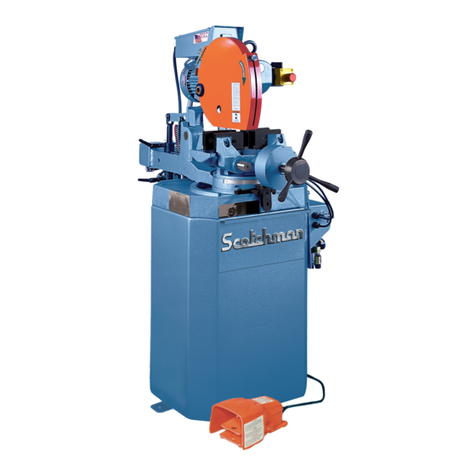
Scotchman
Scotchman CPO 350 User manual

Scotchman
Scotchman CPO-350-NF-5HP User manual
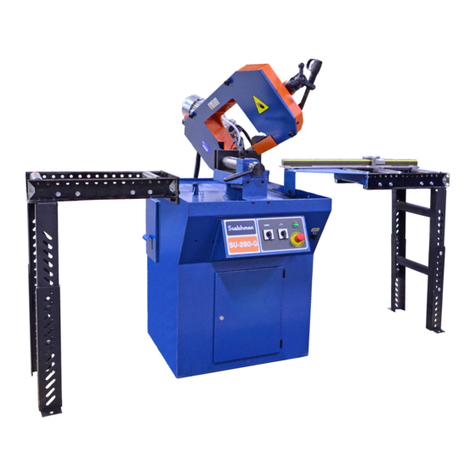
Scotchman
Scotchman SU-280-G User manual
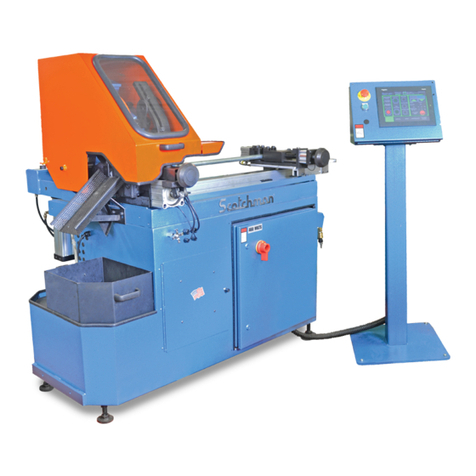
Scotchman
Scotchman CPO-315-HFA-CNC User manual
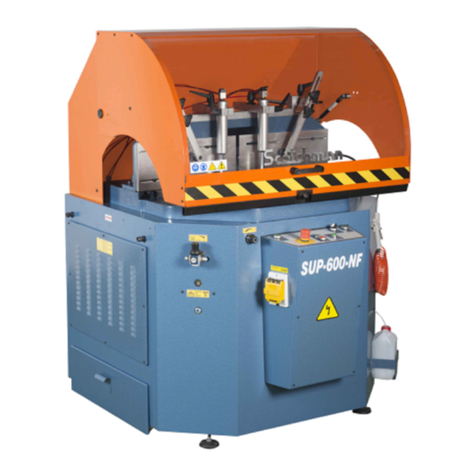
Scotchman
Scotchman SUP-600-NF User manual

Scotchman
Scotchman CPO-315-HFA-5HP User manual

Scotchman
Scotchman CPO-275 User manual
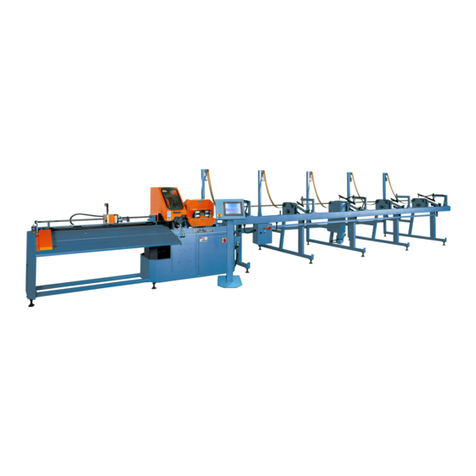
Scotchman
Scotchman CPO-315-RFA-NF User manual

Scotchman
Scotchman SU-280-G User manual
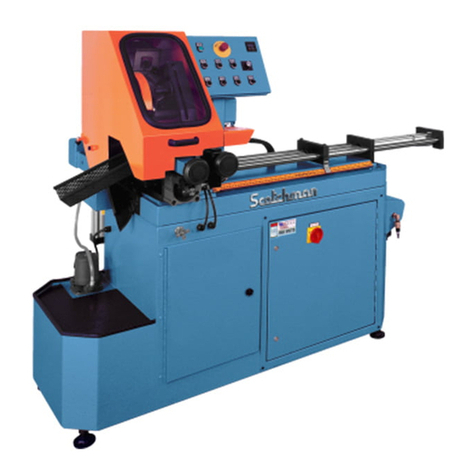
Scotchman
Scotchman CPO-315-HFA-NF User manual


